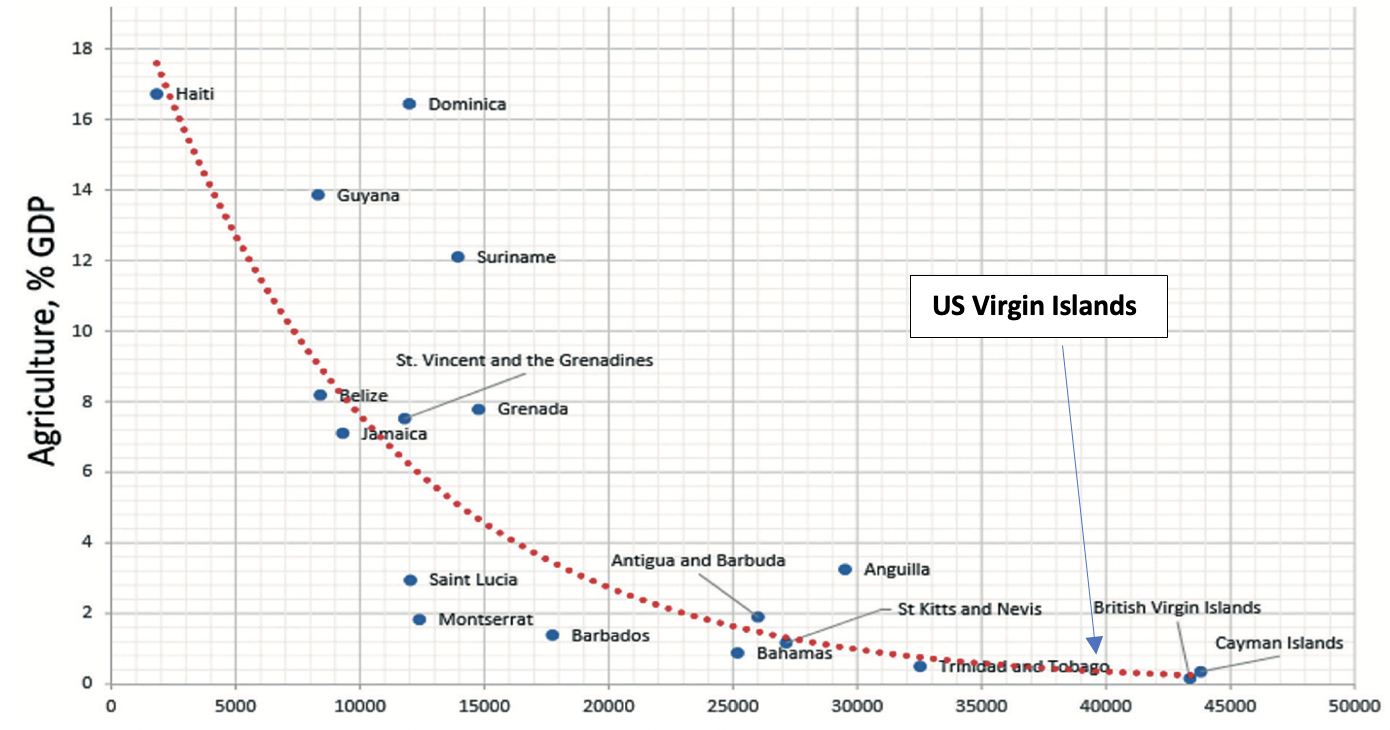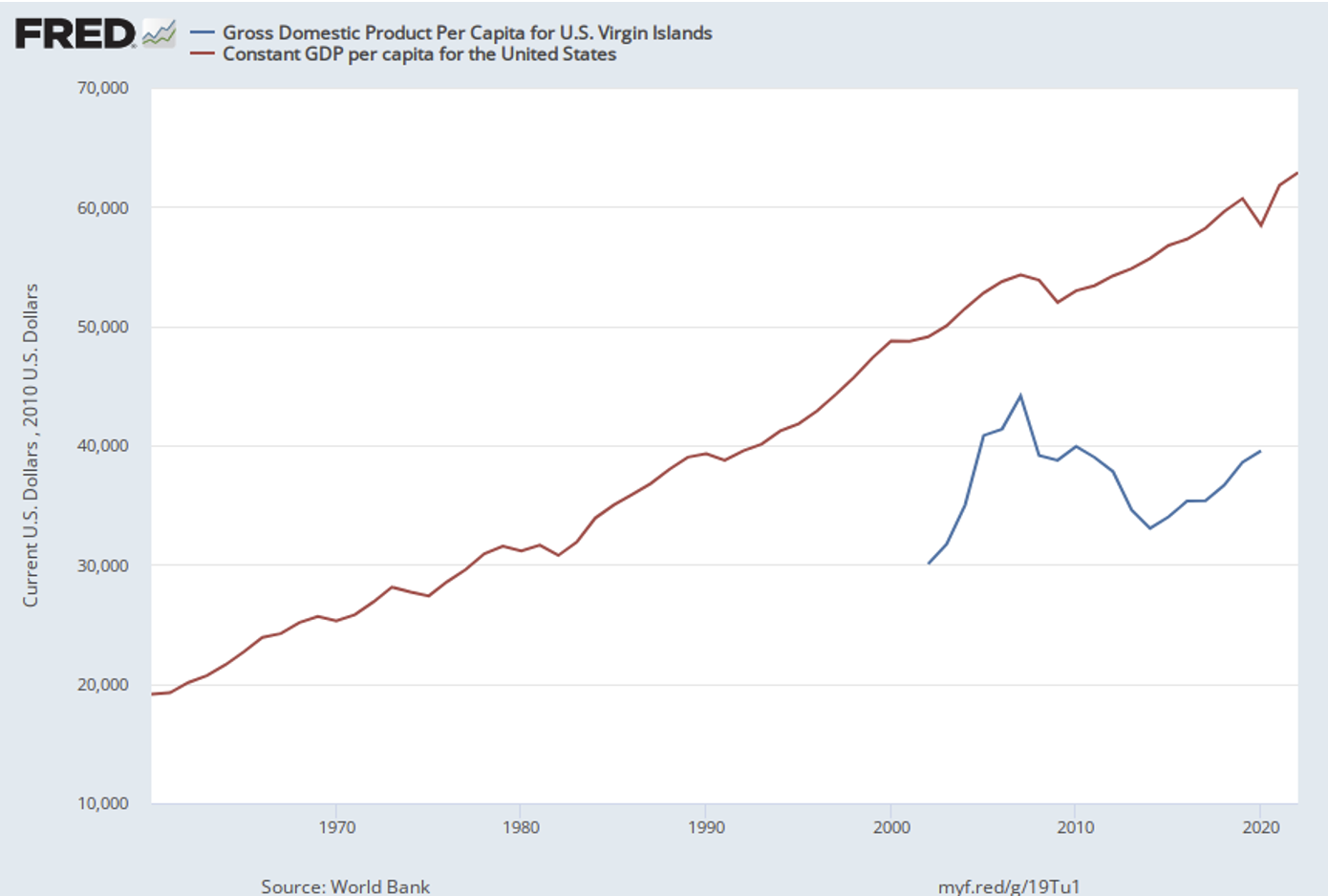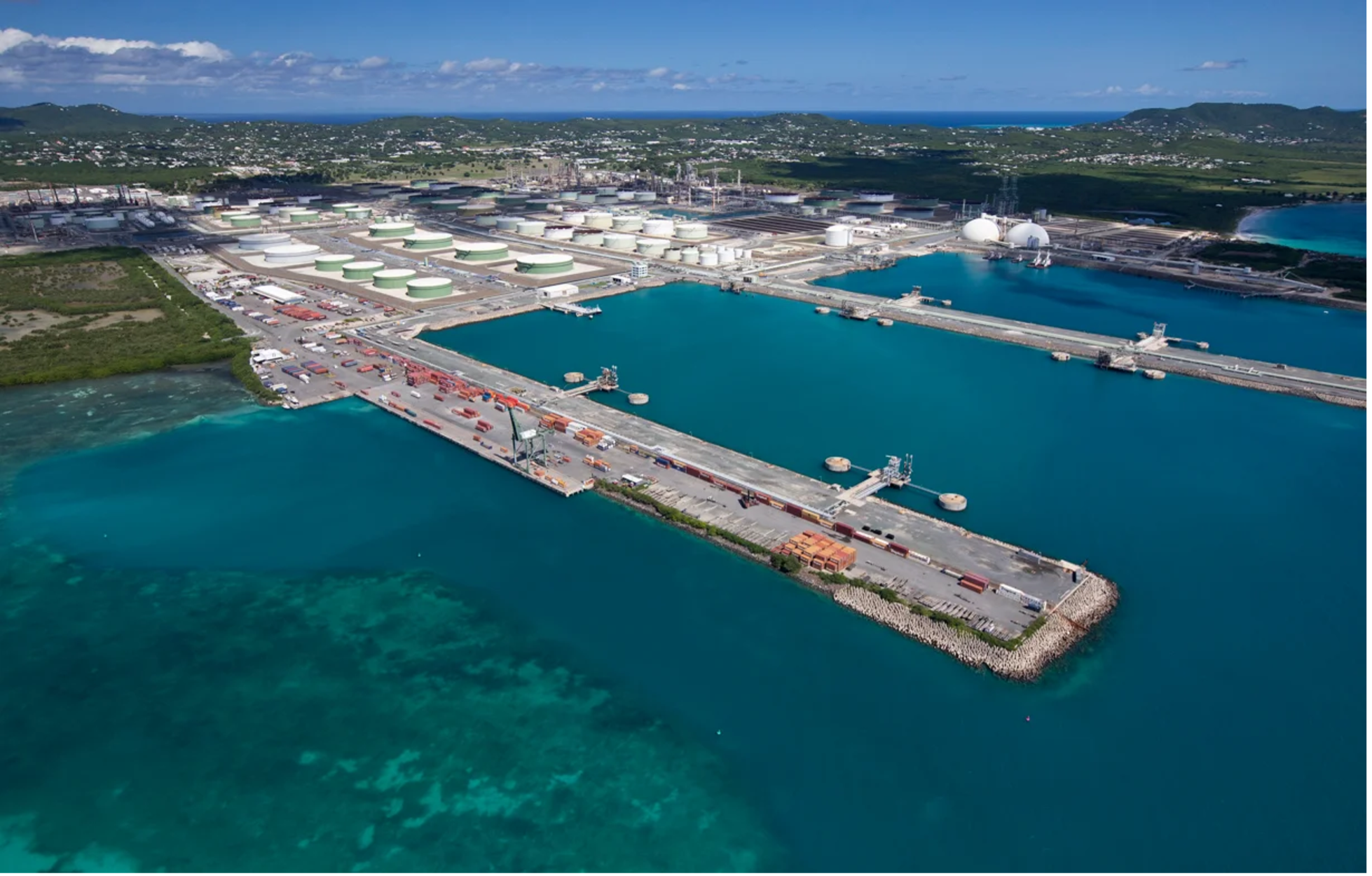I have noticed that the chorus of insanity appears to be at an all-time high, and I have patiently sat and watched as things have developed. While reading last week’s articles, I came across an Op-Ed by Mr. Olasee Davis, entitled Let’s Take the Government to Court Over St. John Land Swap.

In this article, Mr. Davis bemoans the recent land swap on St. John and makes an awkward parallel between the land swap and the development of St. Croix’s south shore by Harvey Aluminum Company and the Hess Corporation. In the best interest of data, I will set aside the discussion of the merits of the recent land swap and leave that debate to others. However, I would like to set the record straight as Mr. Davis parrots numerous misleading statements regarding the economic development of the Virgin Islands. While I appreciate Mr. Davis’ involvement in community-based activism, I would hate for others to read and accept that article as an accurate or complete account.
Fact 1: St. Croix’s Agricultural Industry was Killed by Beets, Not Oil.
Mr. Davis decries, “In the 1960s, politicians killed agriculture on St. Croix, particularly the administration of Gov. Ralph Paiewonsky.” That statement could not be more false or misleading. The agricultural industry on St. Croix was primarily the cultivation of sugar. The entire sugarcane industry in the early 1960s was in upheaval. The sugar industry in the Caribbean was heavily dependent on enslaved labor during the colonial era. The abolition of slavery in the 19th century led to a shortage of cheap labor, making sugar production via cane less economically viable. After emancipation, former slaves sought higher wages and better working conditions, which increased labor costs for sugar plantation owners. This made Caribbean sugar less competitive on the global market. In addition, the development of sugar beet farming and sugar beet sugar extraction methods in Europe provided competition to Caribbean cane sugar. Sugar beet sugar was cheaper, reducing the demand for Caribbean sugar. In addition, global economic shifts, including the end of preferential trade agreements for former colonies and changes in global sugar prices, made it difficult for Caribbean sugar producers to remain competitive. These factors and changing international trade dynamics and consumer preferences led to a significant decline in the Caribbean sugarcane industry.
Roger Iger, CEO of the Walt Disney Company, famously said, “Innovate or die.” Economies must evolve as well, even small economies like ours. In the early 1960s, the sugarcane industry was dying, and the territory was forced to pivot. Mr. Davis bemoaning the death of the sugarcane industry in the 1960s is like someone mourning the end of the cordless phone in 2023. You surely cannot kill a dead horse, and you cannot use it to get anywhere else. So, it is best to acknowledge that the horse is dead, get off it, and move on. Thankfully, Gov. Paiewonsky had the foresight to transition the territory to the next era, and that decision paved the way for the Virgin Islands’ economic prosperity for the next 50 years.
Fact 2: The Hess Oil Corporation and Subsequent Refining-related Activity Have Been a Net Positive for the Territory.
For decades, the Hess Oil Corporation and subsequent refineries have played an instrumental role in shaping the economy of St. Croix and the wider Virgin Islands. Their impact extends far beyond the confines of oil production, reaching into the very fabric of our communities. In 1979, the Hess Corporation struck a deal and broke ground on an $18 million (approximately $80 million in 2023) project, which today is affectionately known to all Crucians as the “Container Port.” Leon Hess needed the Container Port to complement the world’s largest refinery and struck a deal with our former leaders to make St. Croix a central Caribbean cargo point. By doing so, Mr. Hess eliminated the time-consuming and costly shipment of goods through San Juan, Puerto Rico, and provided numerous jobs for Virgin Islanders. By constructing the Container Port, the price of all goods entering the territory was estimated to save residents an estimated 33% in extra freight costs. I want to reiterate that those savings have been realized on all goods, e.g., food, merchandise, and vehicles, from 1981 to the present.
What is more inspiring is that Mr. Hess constructed the terminal in exchange for tax breaks and immediately turned the facility over to the government. This is a model that I would love to see for future large capital projects. In exchange for tax breaks, the government should tap private corporations to complete large projects, following which they hand the asset over to the people of the Virgin Islands. Why? Private corporations are better at completing large, complex, multi-year projects than the government. If a private corporation were to construct the Paul E. Joseph Stadium, it would not have taken 20 years (and counting) and $30 million (and counting). Likewise, if a corporation had managed the VITOL project, it would not have cost the territory’s citizens over $200 million, which was $113 million over budget and $92 million in unapproved change orders. Just imagine if, in exchange for the $300 million in tax breaks that Jeffrey Epstein received, the territory received new hospitals, ports, or other necessary infrastructure. I would much prefer that to the two johnny cakes and the embarrassment we received in return.
Fact 3: The South Shore Industrial Complex Created Numerous High-Paying Jobs and Supported a Black Middle Class on St. Croix.
Hovensa’s closure in 2012 resulted in the loss of 1,200 direct jobs and 950 contractor jobs — 2,150 total jobs, approximately 10% of the St. Croix workforce. However, the economic impact was more widespread because we lost 2,150 high-paying jobs. The V.I. Bureau of Economic Research estimated that Hovensa accounted for 21% of the territory’s gross domestic product (GDP). Then Gov. John de Jongh estimated that the resulting impact on tax revenues was at least $60 million of real property taxes and income taxes paid by Hovensa, contractors, and staff. Based on the 2012 budget, the $60 million represents approximately 9% of net revenue — or, in layman’s terms, about 1 in 10 dollars that the government spent on public services such as education, healthcare, and public infrastructure was generated by the refinery.
The refinery’s closure also impacted my family. My brother, Carl Richards Jr., returned home from the military in the late ’90s with few job prospects. However, through diligence and hard work, he landed a job as an operator at Hovensa. When Hovensa closed, my brother relocated to New Orleans to work for the Shell Corporation as a Class A operator, earning a six-figure salary. He traces his professional success to his start on St. Croix’s south shore. I could not be prouder of my brother and thankful that he could learn skills at that refinery that he could take anywhere in the world. However, my brother is not the only success story resulting from Leon Hess’ decision to construct a refinery on the south shore — there are thousands (of success stories). The best part of these stories is that thousands of local Virgin Islanders could earn an above-average living and support their families for decades. In fact, to this day, Ocean Point operates a storage terminal on the former Hovensa site and remains the territory’s largest private employer, employing more than 650 Virgin Islanders and contractors. Furthermore, the average employee at Ocean Point makes approximately $150,000 per year, more than 2.5 times the average Virgin Islands salary. What else does Mr. Davis propose our young Crucian men and women do to earn a six-figure salary? Plant chibble and cucumbers? I challenge Mr. Davis to identify a thriving, post-colonial island economy powered by agriculture.
The following chart illustrates agriculture’s percent of GDP versus GDP for various Caribbean nations. One can quickly notice a few things:
– Haiti is the Caribbean economy with the most significant agricultural share of GDP at approximately 17%.
– The average Haitian makes less than $2,000 USD per year.
– The islands with higher GDPs are in the bottom right-hand corner, and those with lower GDPs are in the upper left-hand corner. In short, one may conclude that agriculture is labor intensive and reliant on cheap labor — something that the U.S. Virgin Islands do not have.

All jokes aside, we must figure out what will power the Virgin Islands’ economy in 2050 and beyond before it is too late. In my opinion, St. Croix needs a battery factory. With the advent of electric vehicles, the International Energy Agency predicts global energy demand will slow significantly by 2028. Like the early 1960s, the territory needs to diversify its economy into new emerging sectors. Given our workforce, we need to make something. I would love for the Virgin Islands to recruit a battery manufacturer similar to other jurisdictions. For example, Quebec recently lured a $5 billion Northvolt battery factory for electric cars by offering $2 billion in incentives. That factory will employ 3,000 people and be among North America’s most significant battery factories when it begins production in 2026.
Fact 4: The Hess Corporation Made Significant Civic Contributions to the Territory Through Philanthropy, Supporting Education, Healthcare, and Cultural Initiatives.
The condition of our education system has made numerous headlines in recent weeks, but have the conditions gotten worse, or has social media made images of the disrepair more accessible? I contend that our schools have always been in disorder. My mother was a 34-year employee of the Department of Education and an elementary school teacher at the Alexander Henderson School. When I was a child, she was very concerned about the poor state of our schools. She elected to send me to the Good Hope School, which was an enormous sacrifice for our family but instrumental in my educational development and career success. In the early 1960s, the Good Hope School was started with a $250,000 grant (approximately $2.6 million in 2023) from the Hess Corporation. Unfortunately, the Good Hope School closed in 2012 immediately following the refinery’s closure and has remained shuttered. As a proud Good Hope alumnus, I thank the Hess Corporation for creating that institution.
Fact 5: The Virgin Islands Economy Has Not Recovered from HOVENSA’s Closure.
While researching this article, I visited the United States Bureau of Economic Analysis site and was disappointed to learn that our economy peaked in 2007 at $4.78 billion ($44,159 per capita, $65,985 in 2023). 2007! In 2020 (the latest year for which data is available), our economy was $4.20 billion ($39,552 per capita). The Virgin Islander makes approximately $25,000 less than in 2007. That is a depressing fact and a fact that is exacerbated by the lack of funds to operate our government. In recent news, Gov. Albert Bryan Jr. mentioned that we do not have the 10% local match required to participate in $15 billion of disaster-related recovery projects. In other words, if rebuilding a school costs $100, the feds will give us $90, but we must pay $10. That sounds like a great deal, right? However, the only problem is that we do not have $10 and have no plan to generate an additional $10. We need to attract more businesses to the territory. Our livelihood depends on it.

Fact 6: While Refineries Pose Environmental Challenges, Those Challenges are Not Insurmountable.
I fully acknowledge that the oil industry has not been without its challenges, including environmental concerns. However, the industry and the EPA have continuously evolved to address issues. The EPA was created in late 1970 and is a relatively young organization. Thankfully, the EPA has continued to grow its scope, and the businesses it regulates continue evolving. I empathize with residents who live near the south shore industrial complex and fully support efforts to make impacted individuals whole. However, I caution that we should not throw the baby out with the bath water.
Conclusion
The industrial development of St. Croix’s south shore has been good for the Virgin Islands. While challenges exist, the overall impact of the Hess Oil Corporation, the Harvey Corporation, and subsequent companies on the economy of St. Croix and the Virgin Islands has been overwhelmingly positive. These institutions have been vital contributors to our growth and prosperity, and their continued presence holds the potential for a brighter economic future. Too often, we allow the conversation to be dominated by naysayers without a viable alternative pathway to prosperity. Too often, our only position is opposition. I dream of a future St. Croix where we can successfully balance economic development, conservatism, and environmental concerns.
— Jed JohnHope, St Croix, is president of Generation Next, an organization driven to make meaningful, enduring change in our beloved islands. In addition, Mr. JohnHope is a former professional engineer who focused on environmental issues. He is a strategy and finance professional with over 20 years of experience in the Energy, Manufacturing, Financial Services, and Oil and Gas sectors. This experience includes significant work within the USVI. Former employers include Morgan Stanley, the Hess Corporation, Liberty Mutual, and ARCADIS. Mr. JohnHope is a native Crucian and an alumnus of the Good Hope School, the University of Delaware, London Business School, and the Kellogg School of Management at Northwestern University. In his spare time, Jed is an avid chess player, traveler, and CrossFit athlete.







